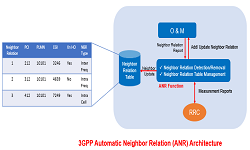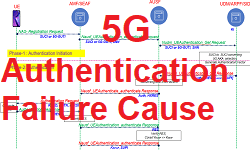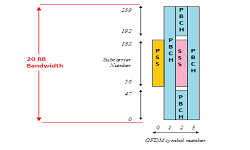5G RACH Procedure Overview – CBRA & CFRA
5G RACH Overview
When we want to connect a UE to 5G network, it has to synchronize in downlink as well as in uplink. Downlink synchronization is obtained after successfully decoding SSB, In order to establish uplink synchronization and RRC connection, UE has to perform RACH random access procedure.
Types of RACH Procedure
-
- Contention Based Random Access (CBRA)
- Non Contention or Contention Free Random Access (CFRA)
- Contention-based Random Access (CBRA): In contention based Random access, UE selects a Preamble randomly from a pool of preambles shared with other UE. This means that the UE has a potential risks of selecting the same preamble as another UE and subsequently may experience conflict or contention. The gNodeB uses a contention resolution mechanism to handle this type access requests. In this procedure, the result is random and not all Random Access succeeds. CBRA is also know as four step RACH Procedure.
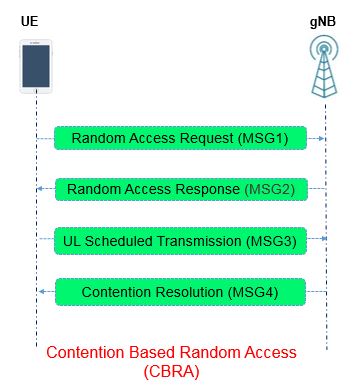
-
-
- Step 1: Random Access Preamble Transmission (Msg1)
-
- UE transmits in the Preamble to the appropriate beam of gNB
-
- Step 2: Random Access Response (Msg2)
-
- Upon receiving a preamble, the gNodeB applies for a TC-RNTI and uplink and downlink scheduling resources. Then, the gNodeB sends an RA response over the PDSCH. The response contains the RA-preamble identifier, timing alignment information, initial uplink grant, and temporary C-RNTI. One PDSCH can carry RA responses to multiple UEs. After the UE sends a preamble, it monitors the PDCCH and waits for an RA response within an RA response window:
- If the UE receives a response containing an RA-preamble identifier which is the same as the identifier contained in the transmitted RA preamble, the response is successful. The UE then transmits uplink scheduling information.
- If the UE does not receive a response within the RA response window or fails to verify the response, the response fails. In this case, if the number of RA attempts is smaller than the upper limit (10), the UE retries RA. Otherwise, RA fails.
- Upon receiving a preamble, the gNodeB applies for a TC-RNTI and uplink and downlink scheduling resources. Then, the gNodeB sends an RA response over the PDSCH. The response contains the RA-preamble identifier, timing alignment information, initial uplink grant, and temporary C-RNTI. One PDSCH can carry RA responses to multiple UEs. After the UE sends a preamble, it monitors the PDCCH and waits for an RA response within an RA response window:
-
- Step 3: Scheduled UL Transmission (Msg3)
-
- The UE sends uplink scheduling information over the PUSCH. The signaling messages and information sent by the UE varies across different RA scenarios and some of the example is listed here
- Initial RRC connection setup: The RRCSetupRequest message (carrying NAS UE_ID) is transmitted over the common control channel (CCCH) in TM at the RLC layer. The message is not segmented.
- RRC connection reestablishment: The RRC Reestablishment Request message (not carrying the NSA message ) is transmitted over the CCCH in TM at the RLC layer. The message is not segmented.
- Handover: Contention-based RA, instead of non-contention-based RA, is triggered if the UE accesses the target cell and no dedicated preambles are available during a handover. The RRC Handover Confirm message and C-RNTI are transmitted over the dedicated control channel (DCCH). If required, a buffer status report (BSR) is also carried.
- Other scenarios: At least the C-RNTI of the UE is transmitted.
- The UE sends uplink scheduling information over the PUSCH. The signaling messages and information sent by the UE varies across different RA scenarios and some of the example is listed here
-
- Step 4: Contention Resolution (Msg4)
-
- After the UE sends Msg3, a contention resolution timer of 4 ms starts. The gNodeB assists the UE in contention resolution using the C-RNTI on the PDCCH or using the UE Contention Resolution Identity IE on the PDSCH.
- The UE keeps monitoring the PDCCH before the timer expires and considers the contention resolution successful and stops the timer if either of the following conditions is met:
- The UE obtains the C-RNTI over the PDCCH.
- The UE obtains the temporary C-RNTI over the PDCCH and the MAC PDU is successfully decoded. Specifically, the UE Contention Resolution Identity IE received over the PDSCH is the same as that carried in Msg3 sent by the UE.
- The UE keeps monitoring the PDCCH before the timer expires and considers the contention resolution successful and stops the timer if either of the following conditions is met:
- If the contention resolution timer expires, the UE considers the contention resolution failed.Then, the UE performs RA again if the number of RA attempts has not reached the upper limit (10). If the number of RA attempts has reached its upper limit, the RA procedure fails.
- After the UE sends Msg3, a contention resolution timer of 4 ms starts. The gNodeB assists the UE in contention resolution using the C-RNTI on the PDCCH or using the UE Contention Resolution Identity IE on the PDSCH.
-
- Step 1: Random Access Preamble Transmission (Msg1)
-
- Contention Free Random Access (CFRA): In non contentions based Random Access, The Preamble is allocated by the gNodeB and such preambles are known as dedicated random access preamble. The dedicated preamble is provided to UE either via RRC signalling (allocating preamble can be specified within an RRC message) or PHY Layer signalling ( DCI on the PDCCH). Therefore, there is no preamble conflict. When dedicated resources are insufficient, the gNodeB instructs UEs to initiate contention-based RA. CFRA is also know as three step RACH procedure.
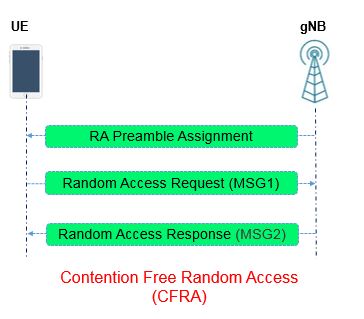
-
-
- Step 1: Random Access Preamble Assignment
- The gNodeB allocates an RA preamble to the UE and sent it using RRC Msg or DCI. Some scenarios is listed here.
- Handover: The MobilityControlInfo IE sent by the source gNodeB carries the allocated preamble
- DL Data Arrival: When downlink data arrives at the gNodeB, the gNodeB instructs the UE to initiate RA through DCI over PDCCH, which carries the allocated preamble
- NSA networking: When NR cells are added in NSA , the gNodeB instructs the UE to initiate RA through the PDCCH, which carries the allocated preamble
- The gNodeB allocates an RA preamble to the UE and sent it using RRC Msg or DCI. Some scenarios is listed here.
- Step 2: Random Access Preamble Transmission (Msg1)
- Step 3: Random Access Response (Msg2)
- The gNodeB sends an RA response.
- Handover: the RA response must contain the timing alignment information and initial uplink grant
- DL Data Arrival: When downlink data arrives at the gNodeB, the RA response must contain the timing alignment information and RA preamble identifier (RAPID)
- NSA networking: When NR cells are added in NSA , the RA response must contain the timing alignment information and RA preamble identifier (RAPID)
- The gNodeB sends an RA response.
- Step 1: Random Access Preamble Assignment
-
RACH Scenarios and RACH Type
-
- Case 1 : Initial RRC connection setup
- Contention Based Random Access
- Case 2: RRC connection re-establishment
- Contention Based Random Access
- Case 3: Handover
- First choice is to choose Non-Contention Based Random Access
- CBRA can be used if all dedicated parables are already being used
- Case 4: Downlink data arrival (PDCCH Order)
- First choice is to choose Non-Contention Based Random Access.
- CBRA can be used if all dedicated parables are already being used
- Case 5: Uplink data arrival
- Contention Based Random Access
- Case 6: Uplink L data arrival during RRC_CONNECTED when no PUCCH resources for SR available
- Contention Based Random Access
- Case 7: Scheduling Request Failure
- Contention Based Random Access
- Case 8: Transition form RRC_INACTIVE to RRC_CONNECTED
- First choice is to choose Non-Contention Based Random Access
- CBRA can be used if all dedicated parables are already being used
- Case 9: Request for Specific System Information (On Demand SI)
- Non-Contention Based Random Access
- Case 10: NR cell addition for NSA networking
- Non-Contention Based Random Access
- Case 10: Beam Recovery
- Non-Contention Based Random Access
- CBRA can be used if all dedicated parables are already being used
- Case 1 : Initial RRC connection setup
References
- 3GPP TS 38.211 NR; Physical channels and modulation
- 3GPP TS 38.221 NR; Medium Access Control (MAC) protocol specification
- 3GPP TS 38.300 NR; NR and NG-RAN Overall description; Stage-2
Related Post

